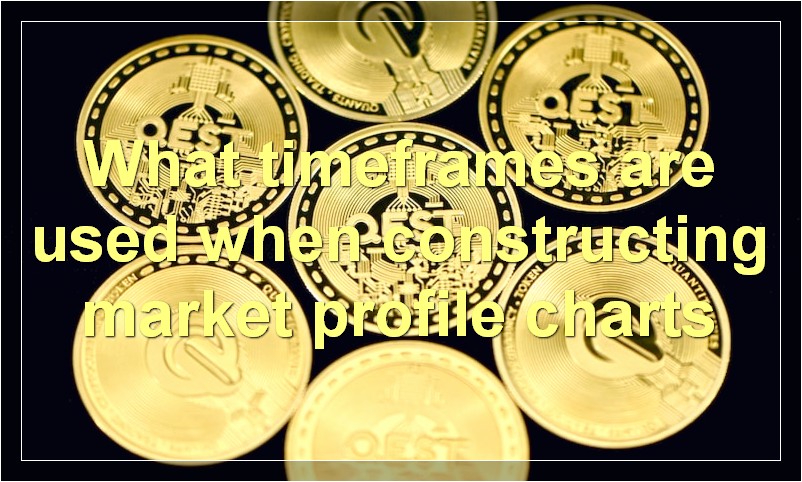If you’re looking to get started with market profile charts, this is the article for you. In this piece, we’ll cover the basics of market profile charts and how they can be used to improve your trading.
How are market profile charts used
Market profile charts are used by traders to identify potential support and resistance levels in the market. By understanding how market participants are likely to trade at certain price levels, traders can make more informed decisions about where to enter and exit trades.
Market profile charts are created by plotting the volume of trading activity at different price levels. This information is then used to create a profile of the market for a specific period of time.
The market profile chart is a valuable tool for day traders, as it can help them to identify potential support and resistance levels in the market. By understanding how market participants are likely to trade at certain price levels, traders can make more informed decisions about where to enter and exit trades.
What information do market profile charts provide

Market profile charts provide information on the price distribution of a security over time. This information can be used to identify support and resistance levels, as well as potential areas of future price movement. Market profile charts can also be used to spot trading opportunities and to make better-informed trading decisions.
How can market profile charts be used to identify trading opportunities
Market profile charts can be used to identify trading opportunities by looking for patterns in the price data. These patterns can be used to predict future market movement and find potential entry and exit points for trades.
One common pattern that can be found using market profile charts is called a bell curve. This occurs when the majority of trading activity is concentrated at a certain price level, with less activity at both higher and lower prices. This can be an indication that the market is about to move in one direction or the other, and traders can use this information to make decisions about their trades.
Another pattern that can be found using market profile charts is called a point of control. This is the price level at which the most trading activity has occurred over a period of time. Traders can use this information to find potential support and resistance levels for their trades.
Market profile charts can provide traders with valuable information about the market. By looking for patterns in the price data, traders can predict future market movement and find potential entry and exit points for their trades.
What is the difference between a traditional chart and a market profile chart
There are a few key differences between traditional charts and market profile charts. Perhaps the most significant difference is that market profile charts show more information about the market, including the distribution of trading activity at different prices throughout the day. This can give traders a better sense of where the market is trading and where it may be headed. another key difference is that market profile charts use a logarithmic scale, which can make it easier to spot trends.
How is market profile data created
In order to create market profile data, traders need to have a clear understanding of how the markets work and what factors influence price movement. This knowledge can be gleaned from experience, observation, and analysis. Once this understanding is attained, traders can begin to look for patterns and develop trading strategies based on these patterns.
One of the most important aspects of market profile data is volume. This data helps traders see how much of a particular security has been traded over a given period of time. It also shows where the majority of buying and selling activity is taking place. This information can be used to identify potential support and resistance levels, as well as potential entry and exit points.
Another important aspect of market profile data is price. This data shows traders where the average price of a security has been over a given period of time. It can also show where the majority of buying and selling activity is taking place. This information can be used to identify potential support and resistance levels, as well as potential entry and exit points.
Lastly, market profile data also includes information on time. This data helps traders see how long it takes for the price of a security to move from one level to another. It can also show where the majority of buying and selling activity is taking place. This information can be used to identify potential support and resistance levels, as well as potential entry and exit points.
What timeframes are used when constructing market profile charts

There are a few different timeframes that can be used when constructing market profile charts. The most common timeframes are daily, weekly, and monthly. However, you can also use intraday data to construct market profile charts.
The advantage of using intraday data is that you can get a more detailed picture of the market. For example, you can see how the market is trading at different times of the day. This can be helpful in identifying patterns and making trading decisions.
The disadvantage of using intraday data is that it can be more difficult to interpret. This is because there is a lot of noise in the data. When you are looking at a daily chart, it is easier to see the overall trend. With an intraday chart, you need to be more careful in interpreting the data.
If you are new to market profile charts, it is best to start with the daily timeframe. Once you are more comfortable, you can try using the intraday data.
How does volume play into market profile charts
In market profile charts, volume plays an important role in helping traders identify potential areas of support and resistance. By understanding how volume is distributed throughout the day, traders can better identify when prices are likely to reverse course.
One way to think about volume is as a measure of market activity. When there is more volume, it means that there are more people trading and there is more interest in the market. When prices are rising on high volume, it is generally seen as a bullish sign, as there is strong buying interest. However, if prices are falling on high volume, it could be a sign that sellers are in control and the market may be due for a correction.
Of course, volume is just one factor to consider when looking at market profile charts. However, it can be a helpful tool for identifying potential turning points in the market.
What other indicators can be used in conjunction with market profile charts
There are a few different types of indicators that can be used in conjunction with market profile charts. Some common ones are volume, price, and time. These indicators can help give you a better idea of the market conditions and how they might change in the future.
One indicator that is often used in conjunction with market profile charts is volume. This is because volume can give you an idea of how much activity is happening in the market. If there is a lot of activity, it may be a good time to buy or sell. If there is very little activity, it may be a good time to wait for the market to move.
Another indicator that is often used with market profile charts is price. Price can give you an idea of where the market is currently at and where it might be headed. If the price is rising, it may be a good time to buy. If the price is falling, it may be a good time to sell.
Time is another indicator that can be used with market profile charts. Time can help you see how the market has been moving over a certain period of time. This can help you make predictions about where the market might go in the future.
What are some of the benefits of using market profile charts
There are many benefits of using market profile charts, including the ability to:
– See the distribution of trading activity throughout the day
– Understand where price is likely to find support and resistance
– Identify potential areas of value
– Make more informed trading decisions
Are there any drawbacks to using market profile charts
Yes, there are some drawbacks to using market profile charts. One is that they can be difficult to read and understand. Another is that they don’t provide as much information as other types of charts, such as candlestick charts.

